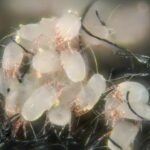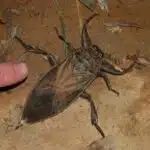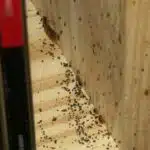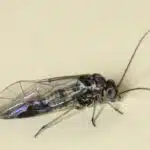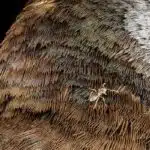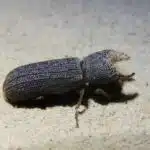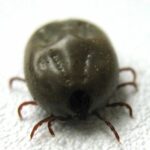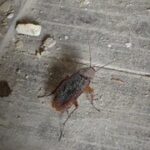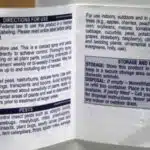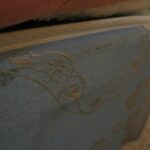Flour mites, also known as grain mites or flour weevils, are tiny insects commonly found in stored grains and flours. These pests feed on various food products, including cereals, nuts, and dried fruits. They are often considered a nuisance due to their ability to contaminate food and cause allergies in humans.
As an entomologist and insect control specialist, I have encountered numerous cases of flour mite infestations. These pests can be challenging to get rid of because they reproduce quickly and are resistant to many pesticides. Therefore, it is essential to take preventive measures that will minimize the chances of an infestation occurring in the first place. In this article, I will share some effective tips on how to get rid of flour mites and prevent them from invading your food storage areas.
Identifying Flour Mites: Signs And Symptoms
Flour mites are tiny pests that can cause a lot of damage to stored food items. These arthropods belong to the Acarina family and are commonly found in flour, cereal grains, and other dry food products. They can be identified by their small size, typically measuring between 0.2 to 0.5 millimeters long, and their white or beige coloration. Additionally, they have eight legs and two body segments.
One of the most noticeable symptoms of a flour mite infestation is the presence of tiny crawling insects in stored food items. These pests are often visible on the surface of flour and other dry goods, but they can also burrow into these materials and remain hidden from sight. Other signs include a musty or stale odor emanating from stored food items, as well as discoloration or mold growth on the surface.
When dealing with a flour mite infestation, it is important to take prompt action to prevent further damage to your stored food items. One solution is to dispose of any contaminated products immediately and thoroughly clean storage areas with hot soapy water or a vinegar solution. Additionally, it may be necessary to use chemical treatments such as insecticides or diatomaceous earth powder to eliminate any remaining pests.
Understanding The Life Cycle Of Flour Mites
Flour mites are small, white or pale-colored insects that infest stored flour and other grain products. They are known to cause significant damage to food supplies and can even pose health risks to humans. Understanding flour mite behavior is crucial in preventing their infestation and controlling their spread.
Flour mites have a life cycle consisting of four stages: egg, larva, pupa, and adult. The eggs are laid on the surface of food materials and hatch within a few days. The larvae feed on the flour, grains, or cereal products for about three weeks before entering the pupal stage. After two to three days, they emerge as adults capable of reproducing. This cycle may repeat several times within one year.
To prevent flour mite infestation, it is essential to keep food storage areas clean and dry. Proper ventilation can also help reduce moisture levels that attract these pests. Additionally, regular inspection of stored foods can help identify any signs of infestation early on. Flour mite control methods include using insecticides specifically designed for this purpose or placing infested items in a freezer for at least 72 hours at -18°C to kill all life stages.
- Regular cleaning of storage containers
- Properly sealing food packaging
- Storing foods in sealed containers
- Using natural predators such as parasitic wasps
Understanding the behavior of flour mites is key to preventing their infestation and controlling their spread. By implementing proper storage methods and regularly inspecting stored foods, you can significantly reduce the risk of an outbreak. In the next section, we will explore common causes of flour mite infestations and what you can do to avoid them.
Common Causes Of Flour Mite Infestations
As an entomologist or insect control specialist, one of the most common problems we encounter is flour mite infestations. Flour mites are tiny creatures that are barely visible to the naked eye, yet they can cause huge problems if left unchecked. In this section, we will discuss the common causes of flour mite infestations.
One of the most common causes of flour mite infestations is poor storage conditions. Flour and other grains should always be stored in a cool, dry place to prevent moisture build-up that can attract these pests. Additionally, it’s important to inspect any new bags of flour before adding them to your pantry or storage area. This will help you catch any potential infestations early on and prevent them from spreading.
Another common cause of flour mite infestations is leaving food out for too long. Flour mites love to feed on anything containing grains or cereals, so leaving food out for extended periods can provide them with an easy source of sustenance. It’s important to store all food items properly and dispose of any expired or spoiled items promptly.
In conclusion, understanding the common causes of flour mite infestations can help you take preventative measures and keep your home free from these pesky creatures. By storing food properly and disposing of expired items promptly, you can reduce the risk of an infestation occurring in your home. In the next section, we will discuss prevention techniques for keeping flour mites at bay.
Prevention Techniques: Keeping Flour Mites At Bay
Flour mites are a common household pest that can cause significant damage to stored food items. Knowing the common causes of flour mite infestations is important, but equally important is knowing how to get rid of them. Prevention strategies and early detection are key to successful control.
Prevention strategies should focus on eliminating conditions that favor flour mite infestations. This includes keeping food storage areas clean and dry, and storing food items in airtight containers. Additionally, regularly inspecting and cleaning food storage areas can help identify potential infestations before they become too severe.
Early detection is important because once an infestation becomes established, it can be difficult to eliminate. Signs of an infestation include webbing or clumping in stored food items, as well as the presence of live mites or their eggs. If an infestation is suspected, immediately remove and discard any contaminated food items and thoroughly clean the affected area with soap and water.
In order to prevent future infestations, it is important to inspect and clean all food storage areas on a regular basis. This can help identify any potential problems before they become too severe, allowing for early intervention and control measures to be implemented. By following these prevention strategies and practicing early detection techniques, homeowners can successfully get rid of flour mites and keep their stored foods safe from harm.
Inspecting And Cleaning Food Storage Areas
Inspecting food storage areas, such as shelves, cabinets, and walls, is the first step in controlling pests. Cleaning crevices, cracks, and other areas is essential for the prevention of pests. Stored food should be contained in sealed containers to prevent contamination. Vacuuming should be done regularly to remove debris and eggs. Refrigerators and freezers should also be regularly inspected and cleaned. Finally, drains should also be checked and any excess moisture should be eliminated.
Inspecting
Flour mites are pesky insects that can easily infest your food storage areas if you’re not careful. As an entomologist, it is crucial to understand how to properly inspect for flour mites in order to prevent an infestation from occurring. Inspecting for flour mites should be a routine task performed regularly to ensure that your food storage area remains free of these pests.
To properly inspect for flour mites, start by checking any open containers of flour or other grains. Look for signs of webbing or small holes in the packaging as this is often an indication that flour mites are present. Additionally, check the corners and crevices of your pantry shelves and any cracks in the walls or flooring where these insects may be hiding. Don’t forget to inspect any kitchen appliances, such as mixers or blenders, where leftover flour may be present.
One of the most obvious signs of a flour mite infestation is the presence of tiny brown or black insects crawling around your food storage area. However, it’s not always this easy to spot them. Flour mites are incredibly small and difficult to see with the naked eye, so it’s important to look out for other signs as well. Keep an eye out for tiny white specks on your food or shelving – these could be mite eggs – and look for clumps of flour that appear to be moving on their own. By carefully inspecting all areas where flour and grain products are stored, you can catch a potential infestation before it becomes a major problem.
Remember: prevention is key when it comes to dealing with flour mites! Regularly inspecting your food storage areas is just one step in ensuring that your pantry remains pest-free. With careful attention and diligence, you can keep these pesky insects at bay and enjoy your favorite baked goods without worry!
Cleaning
After inspecting your food storage areas for flour mites, the next important step is to clean them thoroughly. Cleaning plays a crucial role in preventing pest infestations, especially when it comes to flour mites. As an entomologist or insect control specialist, I highly recommend following these cleaning tips and DIY solutions to maintain a pest-free pantry.
Start by removing all the items from your shelves and wiping them down with a damp cloth. Pay close attention to corners and crevices where flour and other food particles may accumulate. Use a vacuum cleaner with a hose attachment to clean hard-to-reach areas such as cracks in walls or flooring. Dispose of any contaminated food items or packaging that may be harboring flour mites.
Next, mix equal parts of water and vinegar in a spray bottle and use it to wipe down your shelves and pantry walls. Vinegar is a natural disinfectant that can kill bacteria, mold, and even pests like flour mites. You can also add essential oils like peppermint or tea tree oil to the solution for added pest-repelling properties.
Finally, consider using diatomaceous earth (DE) as a long-term solution for preventing flour mite infestations. DE is made up of microscopic fossilized algae that have sharp edges that can cut through the exoskeletons of insects like flour mites. Simply sprinkle DE around your pantry shelves and other areas where you’ve noticed flour mites before. With these cleaning tips and DIY solutions, you can ensure that your food storage areas remain free from pesky pests like flour mites.
Pests
When it comes to inspecting and cleaning food storage areas, one of the most critical aspects is preventing pest infestations. As an entomologist or insect control specialist, we understand the importance of taking preventive measures to avoid potential problems in the future.
One proactive approach to preventing pests from invading your pantry is by keeping your food storage areas clean and tidy. Regularly inspecting your shelves, floors, and walls for signs of pest infestation can help you identify any issues early on before they become more challenging to manage. Additionally, implementing extermination techniques such as natural repellents or pheromone traps can also be effective.
If you do discover a pest problem in your pantry, it’s crucial to take immediate action to address it. This may involve using pesticides or other extermination methods that are safe for both humans and pets. Remember that prevention is always better than cure when it comes to dealing with pests in your home. By taking steps to keep your food storage areas clean and free from pests like flour mites or other insects, you can ensure that your family enjoys healthy meals without worrying about contamination or infestation issues.
Proper Storage Of Food Products
As an entomologist or insect control specialist, your goal is to ensure that food products remain safe for consumption. Flour mites are a common pest that can contaminate flour and other grain-based products. Proper storage techniques can help prevent infestations and keep your kitchen free from these unwanted guests.
One important factor in proper storage is temperature control. Flour should be stored in a cool, dry place away from direct sunlight. Ideally, the temperature of the storage area should be below 70°F (21°C) to discourage mite growth. Additionally, storing flour in airtight containers can prevent moisture and pests from entering.
Labeling and product rotation are also key components of proper storage. It’s important to label all food products with their expiration dates and use them before they expire. This helps ensure that you’re not using old or stale ingredients that may have been contaminated by pests. Additionally, rotating your stock so that older products are used first can help prevent pest infestations by reducing the amount of time food spends on the shelf.
Moving forward, it’s important to recognize that proper storage techniques are just one step in preventing flour mite infestations. The next section will cover how temperature and humidity control can further reduce the risk of contamination in your kitchen.
Temperature And Humidity Control
Temperature and humidity control is crucial in eliminating flour mites. Flour mites thrive in warm and humid environments, so keeping the temperature below 70°F (21°C) and the relative humidity below 50% can significantly reduce their population. This can be achieved by using air conditioning or a dehumidifier.
Dehumidifier usage is an effective way to eliminate flour mites. A dehumidifier can help regulate the humidity level in a room, preventing it from reaching levels that are favorable for mite growth. It is important to choose a dehumidifier that is appropriate for the size of the area it will be used in, as well as regularly cleaning and maintaining it to ensure its effectiveness.
Temperature control techniques can also be used to get rid of flour mites. Keeping storage areas cool and dry can help prevent infestations from occurring in the first place. In addition, storing flour and other grain products in sealed containers can also help limit exposure to moisture, which will deter mites from thriving. By implementing these techniques, you can effectively eliminate flour mites from your home or business environment.
Proper temperature and humidity control are essential steps in getting rid of flour mites. Using a dehumidifier to keep humidity levels low combined with storing grain products in sealed containers helps prevent future infestations while reducing existing populations. The next step is using airtight containers to store your goods properly, which will be discussed in detail in the subsequent section.
Using Airtight Containers
After ensuring that the temperature and humidity is controlled, it is important to consider using airtight containers to prevent flour mites. This can be done through vacuum sealing or storing the flour in glass jars with tight-fitting lids. By doing so, we eliminate any possibility of mite infestation caused by external factors like air and moisture.
Vacuum sealing is an effective method of sealing food items to prevent spoilage and insect infestations. Flour mites are notorious for infiltrating small crevices and cracks in packaging, but vacuum sealing eliminates this possibility altogether. Glass jars, on the other hand, offer another great alternative for preventing flour mites. These jars come with airtight lids that effectively keep out air and moisture while maintaining freshness.
In conclusion, controlling temperature and humidity conditions while also employing vacuum sealing or glass jars with tight-fitting lids will go a long way in preventing flour mites. However, there are natural remedies that can be used as well to eliminate these pests. Let us explore these remedies further in the subsequent section.
Natural Remedies For Flour Mites
When it comes to getting rid of flour mites, there are a variety of remedies available. Some people may prefer natural remedies over chemical ones, for a variety of reasons. Natural remedies can be more environmentally friendly and safer for humans and pets, particularly if they involve food products. However, it’s important to compare the effectiveness of natural versus chemical remedies before making a decision.
One natural remedy that has been found to be effective against flour mites is freezing. Simply place the affected flour or other grain product in an airtight container and freeze it for at least three days. This will kill any mites present in the product. Another option is to use essential oils such as peppermint or tea tree oil, which have insecticidal properties. Simply add a few drops to your flour or other grain product before storing it.
While natural remedies can be effective against flour mites, they may not work as quickly or thoroughly as chemical ones. Chemical options such as pesticide sprays or fumigation can quickly eliminate an infestation, but they come with their own risks and downsides. It’s important to carefully consider all options and weigh the pros and cons before deciding on a course of action.
- Bullet point list
- Frustration can arise when dealing with an infestation
- A sense of helplessness when pests invade our space
- The desire for quick resolution motivates us to find solutions
- The satisfaction of conquering pests fuels this desire
In summary, there are both natural and chemical remedies available for getting rid of flour mites. While natural options may be preferred by some due to their safety and environmental benefits, it’s important to compare the effectiveness of all available options before making a decision. In the next section, we will explore diatomaceous earth: the ultimate flour mite killer.
Diatomaceous Earth: The Ultimate Flour Mite Killer
As an entomologist, I have witnessed the devastating effects of flour mite infestations on households and commercial establishments. These tiny pests can quickly multiply, causing contamination of food and other products. Fortunately, there is a natural solution that can effectively eliminate flour mites: diatomaceous earth.
Diatomaceous earth is a powdery substance made from the fossilized remains of aquatic organisms called diatoms. When viewed under a microscope, it looks like a collection of sharp glass shards with razor-sharp edges that can puncture the exoskeletons of insects. This substance has been used for centuries as an insecticide due to its efficacy in killing various household pests without harming humans or pets.
The benefits of using diatomaceous earth for flour mite control are numerous. Not only is it an all-natural solution, but it is also affordable and easy to apply. To properly use diatomaceous earth for flour mite control, simply sprinkle it evenly in affected areas such as cupboards, pantries, and other storage spaces. Allow the powder to sit for several hours before vacuuming up any excess residue. Repeat this process every few days until you no longer see any signs of infestation.
When it comes to dealing with flour mites, prevention is key. However, if you already have an infestation, using diatomaceous earth can be a highly effective solution. With its many benefits and simple application process, this natural remedy is worth considering for anyone dealing with these pesky insects in their home or business setting. In the next section, we will discuss chemical solutions for flour mite infestations that may be necessary for severe cases.
Chemical Solutions For Flour Mite Infestations
Chemical control is often used as an effective solution to flour mite infestations. Insecticides such as pyrethroids are often applied directly to flour mite infested areas in order to reduce mite populations. Non-chemical solutions, such as vacuuming, may also be implemented as a way to reduce flour mite populations, although the efficacy of this method can vary. To further reduce flour mite populations, non-chemical control solutions such as refrigeration and sanitation are also recommended. The use of insect growth regulators can also help reduce flour mite populations, as they work to disrupt the reproductive cycle of the mite. Finally, the use of traps and baits can also be effective in controlling flour mite infestations.
Chemical Control
Flour mites can be a frustrating pest to deal with, especially when they infest our food products. Chemical control is one of the most effective ways to eliminate these pests. There are several pesticide options available for use against flour mites, but it is important to consider safety measures before using any chemicals.
One option for chemical control is insecticidal sprays that contain pyrethroids or organophosphates. These sprays are effective in killing adult flour mites and can also prevent eggs from hatching. However, it is crucial to read and follow the instructions on the label carefully to ensure proper use and safety. It is recommended to wear protective clothing, such as gloves and a mask, when applying these sprays.
Another chemical solution is fumigation, which involves exposing the infested area to a gas that kills flour mites. This method is highly effective in achieving complete elimination of the pests, but it requires professional expertise and specialized equipment for safe application. Additionally, fumigation may not be suitable for all environments due to potential health hazards and legal restrictions.
In conclusion, chemical control can be an effective solution for eliminating flour mite infestations. However, it is essential to prioritize safety measures when using pesticides or fumigation methods. Consulting with a professional entomologist or insect control specialist can provide valuable guidance on selecting appropriate chemical solutions and ensuring safe application practices.
Insecticides
Chemical solutions are one of the most effective ways to combat flour mite infestations. Among these solutions, insecticides are commonly used to eliminate these pests. Insecticides contain chemicals that target and kill adult flour mites and their eggs. These chemicals can be applied as sprays or fumigation, depending on the severity of the infestation.
Using repellents is another approach in preventing flour mite infestations. Repellents work by masking attractive scents that may lure flour mites into a particular area. Some essential oils such as peppermint, eucalyptus, and cedarwood have been found to be effective in repelling flour mites. However, it is important to note that repellents only serve as preventive measures and may not entirely eradicate an existing infestation.
Biological control is another alternative for managing flour mites without using chemical solutions. This method involves using natural predators or parasites that feed on flour mites or their eggs. Some examples of biological control agents include predatory mites, parasitic wasps, and nematodes. Biological control is generally considered safe and environmentally friendly; however, it may take longer to achieve complete eradication compared to using chemical solutions.
Non-Chemical Solutions
While chemical solutions are effective in eliminating flour mites, they may not be the best option for everyone. Some individuals may prefer natural solutions due to health or environmental concerns. Natural solutions include DIY methods that do not involve using chemicals, biological control, and repellents.
DIY flour mite removal is a popular choice for those who want to avoid using chemicals. This method involves cleaning and sanitizing storage areas thoroughly to remove any food debris or residue that might attract flour mites. Vacuuming containers and shelves can also help eliminate existing infestations. Additionally, placing bay leaves or cloves in storage containers can repel flour mites due to their strong odors.
Biological control agents such as predatory mites and parasitic wasps are a natural alternative to chemical solutions. These agents feed on flour mites or their eggs and can help reduce the population over time. However, it is important to note that biological control may take longer to achieve complete eradication compared to using chemical solutions. It is also crucial to ensure that the selected agent does not harm other beneficial insects present in the area.
Seeking Professional Help For Flour Mite Removal
For individuals who are dealing with a flour mite infestation, seeking the help of a professional exterminator is often the best course of action. While there are several DIY removal methods that can be attempted, these may not always be effective in fully eliminating the mites from the home. A professional exterminator has the expertise and equipment necessary to address the issue in a comprehensive manner.
Professional exterminators will typically begin by conducting an inspection of the affected area to determine the extent of the infestation. They will then develop a treatment plan tailored to the specific needs of the home and its inhabitants. This may involve using insecticides or other chemical treatments, as well as implementing preventative measures to keep future infestations at bay.
While it may be tempting to attempt DIY removal methods, these can often be time-consuming and ineffective. Additionally, some methods may even exacerbate the problem by spreading the infestation to other areas of the home. By enlisting the help of a professional exterminator, individuals can rest assured that their flour mite problem will be effectively addressed, allowing them to focus on other important aspects of their lives.
Transition: Although professional help is essential for getting rid of flour mites effectively, it’s also important for individuals dealing with this issue to be aware of potential allergies associated with these pests.
Dealing With Flour Mite Allergies
Professional pest control services are often the best option for removing flour mites from a home. These experts can identify the source of the infestation and take the necessary steps to eliminate it. In addition, they have access to pesticides that are effective in killing flour mites without harming humans or pets.
However, even after professional treatment, some people may still experience symptoms of allergies caused by flour mites. Coping with these allergies involves identifying and avoiding exposure to the allergen. This might include cleaning regularly and thoroughly, storing food properly, and using air filters to remove dust and other particles from the air.
Medical treatment options for flour mite allergies include antihistamines, nasal steroids, decongestants, and immunotherapy. Antihistamines block histamine release in response to an allergen exposure, while nasal steroids reduce inflammation in the nasal passages. Decongestants relieve congestion caused by swollen nasal tissues. Immunotherapy involves gradually exposing a person to small doses of an allergen over time in order to desensitize the immune system.
To maintain a clean and healthy home environment that is free of flour mites and other pests, it is important to take preventative measures such as sealing cracks and crevices where pests can enter, storing food items in sealed containers, emptying trash cans regularly, vacuuming carpets and upholstery frequently, and washing bedding and linens in hot water weekly. By implementing these measures consistently over time, homeowners can reduce their risk of future infestations and keep their homes safe from harmful pests.
Maintaining A Clean And Healthy Home Environment
Imagine walking into your kitchen to prepare a delicious meal, only to find flour mites crawling all over your pantry. This can be a common problem for many households and can lead to food contamination and health risks. However, maintaining a clean and healthy home environment is crucial in preventing pest infestations.
Here are some tips for maintaining a clean kitchen:
Clean up spills immediately: Any food or liquid spills should be cleaned up immediately as they attract pests like ants, cockroaches, and rodents.
Store food properly: Store food in sealed containers or in the refrigerator to prevent pests from accessing them.
Dispose of garbage regularly: Garbage cans should be emptied frequently to avoid attracting pests.
Effective cleaning products for a healthy home include:
Vinegar: It is an excellent natural cleaning agent that can remove dirt, grime, and bacteria.
Baking soda: It is an abrasive cleaner that can also deodorize surfaces.
Lemon juice: It has antibacterial properties and can remove stains and odors.
Maintaining a clean and healthy home environment is essential in preventing pest infestations. Following these tips will not only help keep your home free from pests but also promote good health for you and your family.
To prevent flour mite infestations, it is important to have a prevention checklist that includes tips on proper storage of grains, regular cleaning of the pantry area, and inspection of packaged goods before purchase. In the next section, we will discuss the flour mite prevention checklist: tips and tricks for ensuring that your pantry remains free from these pesky insects.
Flour Mite Prevention Checklist: Tips And Tricks
Flour mites are a common household pest that can lead to contamination of food products. Preventing flour mite infestations is key to avoiding costly waste of food products and potential health risks. Here are some effective techniques for flour mite prevention.
Firstly, it is important to keep your kitchen clean and free of crumbs or spills. Flour mites thrive in dark, warm, and moist environments. Therefore, keeping the kitchen area dry and well-ventilated can help prevent their infestation. Also, store all food products in air-tight containers to prevent flour mites from accessing them.
Secondly, inspect all new food products before bringing them into your home. Flour mites often travel on contaminated goods such as cereal boxes or sacks of flour. If you notice any signs of infestation such as tiny white bugs crawling around the packaging material, do not bring the product into your home.
Lastly, consider using natural remedies for flour mite prevention such as bay leaves or cinnamon sticks which have been shown to repel these pests. Additionally, freezing any new food items for at least 48 hours upon arrival can also prevent an infestation from occurring.
Overall, by following these simple yet effective techniques for preventing flour mites from taking over your pantry and kitchen space you can ensure the safety and quality of your food products while avoiding unwanted waste and potential health hazards.
Conclusion
Flour mites are a common household pest that can cause a lot of headaches and frustration for homeowners. These tiny insects can infest flour, cereal, and other dry goods, contaminating them with their waste and causing allergic reactions in some people. Identifying the signs and symptoms of a flour mite infestation is the first step in getting rid of these pesky bugs.
Understanding the life cycle of flour mites, as well as their common causes of infestation, can help prevent future outbreaks. Consistent cleaning and inspection of food storage areas is also crucial to keep these pests at bay. Seeking professional help may be necessary in severe cases, but maintaining a clean and healthy home environment is the best way to prevent flour mite infestations from occurring.
As insect control specialists, we understand the frustration that comes with dealing with flour mites. These tiny insects can wreak havoc on your pantry and your health if left unchecked. By following prevention techniques and maintaining a clean home environment, you can minimize the risk of flour mite infestations. Don’t let these pests take over your kitchen – take action today to get rid of them for good!
Image Credits
- “flour mould mite” by lucianls (featured)


